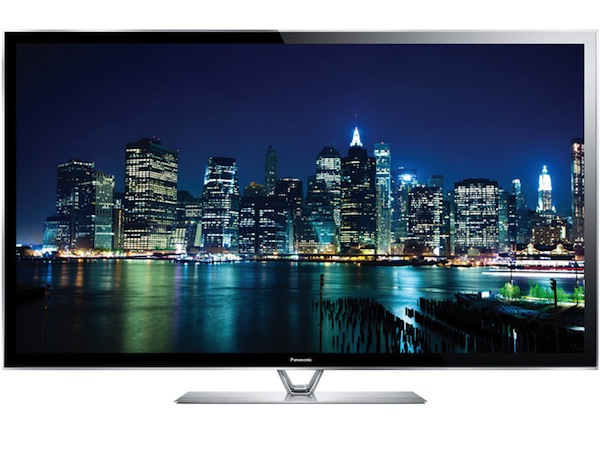Why Panasonic Ending Plasma TV Production is No Surprise
The Japanese electronic giant announces that this year will be the last one they manufacture plasma televisions.

After a report on Reuters earlier this month that Panasonic would be shutting down its Plasma television business, the Japanese electronics company has announced today that its three remaining factories in Japan would stop producing plasma televisions in December. The company shut down three other plasma-display factories in 2012.
The reason for Panasonic’s departure from the plasma business is not hard to see. In 2012, U.S. consumers spent $2.15 billion buying 2.98 million plasma TVs; by 2015, the forecast is just 1.33 million sets for a total of $923 million, according to Steve Koenig, director of industry analysis at the Consumer Electronics Association. Comparatively, Americans purchased 36.2 million LCD televisions for a total of $16.8 billion in 2012.
MORE: 4 Reasons Not to Get a 4K TV — Yet
Despite this shift, Panasonic increased its profit forecast for the year today from 250 billion yen to 270 billion yen, about $2.75 billion. The company cited strong sales of automotive displays and the plan to increase sales of batteries to Tesla motors from 200 million cells over the last two years to a total of two billion cells by 2017.
Panasonic’s Plasma televisions have been lauded for their color quality and deep blacks. And plasma TVs generally have wider viewing angles and better clarity of motion in the picture, compared to LCD and LED-LCD televisions. But, regardless, the latter televisions have come to dominate the market.
The television industry is progressing toward LED sets with 4K resolutions, or Ultra HD as it is sometimes known. Panasonic currently sells a 65” LED-LCD with 4K and has already announced that a 56-inch OLED with 4K is in production.
Follow Kevin Ohannessian at @khohannessian and on Google+. Follow us @tomsguide, on Facebook and on Google+.
Sign up to get the BEST of Tom's Guide direct to your inbox.
Get instant access to breaking news, the hottest reviews, great deals and helpful tips.
Kelly Ohannessian is a freelance writer and editor. With more than 15 years of experience, she works with a focus on covering the creative aspects of the gaming industry. Her articles have appeared on Medium, Fast Company, Tom's Guide, Laptop Mag, Gamespot, and many more. Currently, she works as a manager at Brooklyn Game Lab.
-
wolley74 Plasma tech would have been awesome if it would have kept getting enhanced. Most LED Tvs stilkl cannot beat a plasma thats the same price from a great company, will be sad to see them go when plasma ever dies, LED just cannot match it yetReply -
matt_b I think the image burn issue with the earlier models may have scared a lot of the buying public. Although problems can be fixed over time, sometimes an initial problem isn't forgotten and remains urban legend even after it has been mostly resolved. Plasma Power consumption is still higher than the counterpart and always has been.,You cannot beat some of the amazing contrast and saturation this display has though. It's a shame Panasonic is leaving the business, I don't think many will disagree that they consistently produced the best picture quality with plasma.Reply -
Christopher Shaffer @wolley74: You should check out Samsung's plasma line-up. They still "enhance" them with each generation and make very good quality TVs (considering they make the display for most companies building LEDs, too, they clearly know what they're doing).Reply
I own a Samsung plasma about 1 year old and it's one of the best pictures I've ever seen. The response time for console gaming can't be beat, the motion blur is non-existent. In comparison, a standard LCD simply doesn't match up for motion blur issues, though a quality LED-LCD gets very close; high-end LEDs match up to plasmas, but just in the last couple years.
Color depth on plasmas also can't be beat. On top of that, Samsung has basically eliminated burn-in (unless you leave a static image on the screen for hours which is jus stupid).
I'll be sad if/when Samsung quits producing plasmas. I'm starting to like a lot of the modern LEDs, but I don't see other manufacturers stopping plasmas to fall in line with Panasonic. They're hardly an industry leader in TVs.
That said, it's unfortunate that the *myths* about plasmas have persisted even through the last few generations of improvements in them. -
christexan I think marketing has just really let down plasma, probably because of the beancounters. Plasma displays are generally more expensive to produce at a given quality level, and since it's often hard to properly market "this 60" TV has more contrast and deeper saturation than this other 60" TV, and only costs 40% more!", basically other flat-panel tech has taken off. 9 out of 10 consumers know "I want a big flat TV, say 42" to put in the living room, I see this ad for one at $899, Hi-Def, 1080P, and this other one, Hi-Def, 1080P, at $1299.... I'll go for $899." They don't stop to ask why the price difference, or more importantly, do a quality side-by-side review doing direct source material (not shared in-store signals under bright flourescent lights). Put "The 5th Element" Blu-Ray direct to a top-quality backlit panel (LED or Flouro, doesn't matter), and a top-quality plasma of the same dimensions, and it'd be no contest. But most stores that have anything on display, will put the "average" quality plasma, next to the top quality LED, and say "see, not much difference". Gone are the days of high-end showrooms, with well-trained staff, actually SELLING features, instead of just moving boxes.Reply -
10tacle My first big screen was an HD plasma, a 2006 Samsung 42" 720p. The power consumption is atrocious and the heat output is brutal (great in the winter time though). However, it still has a better picture than my 1-year old LG 47" LED minus the resolution difference. It's tempting to go out and get one final plasma while waiting for 4K TVs to drop in price and cable/satellite format to offer enough 4K channels to make it worthwhile. We are several years away from that still.Reply -
jldevoy The main issue for me was the power usage, i couldn't find an affordable 1080p plasma that didn't use 3-4x the power of the LCD tv i got.Reply -
david__t Plasma reached a kind of pinnacle with the Pioneer Kuro and since OLED is on the horizon (which will be so much better than any tech that has gone before) it makes sense to stop production now and focus on the future. 4K will go the way of 3D eventually with the sheer lack of content killing it off, but OLED will be here to stay.Reply
